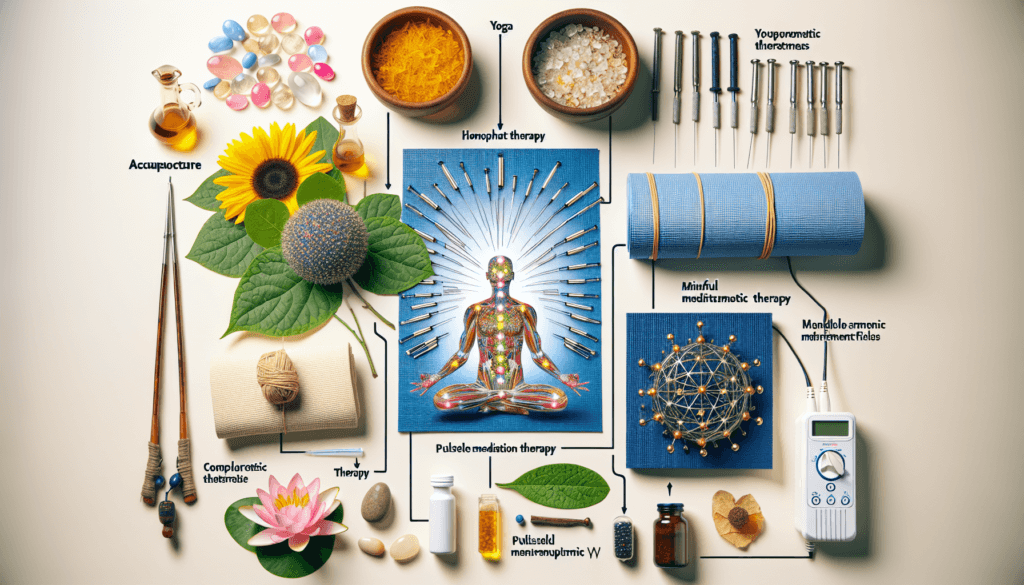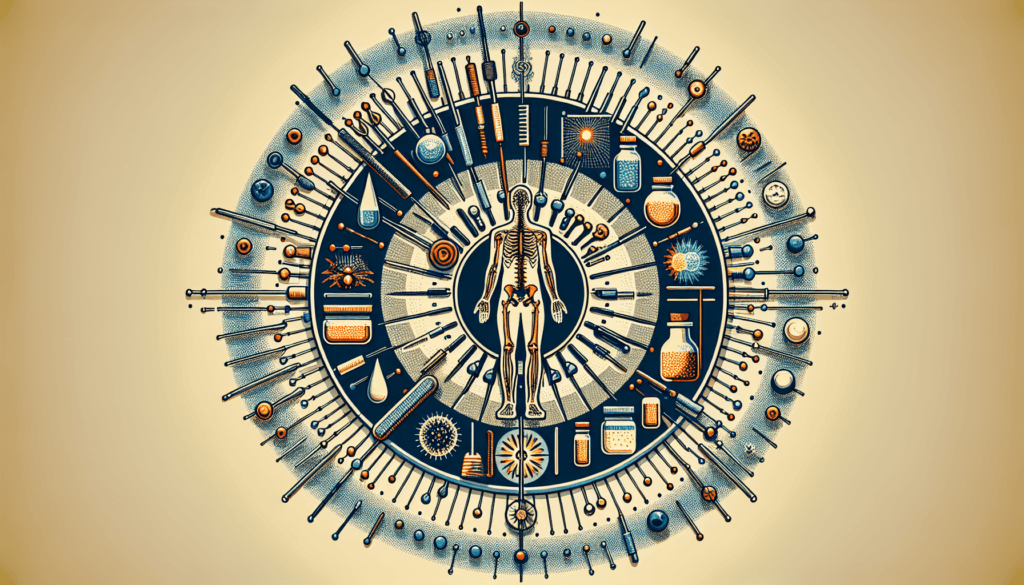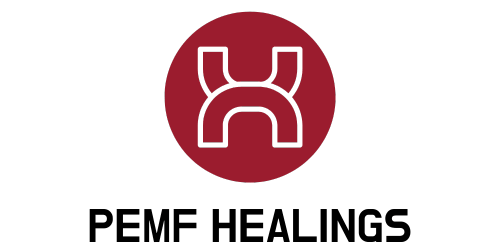In the realm of alternative therapies, there is a growing buzz surrounding PEMF therapy. But amidst the myriad of options available to improve your health and well-being, how does PEMF therapy truly stack up against other alternatives? Well, let’s take a closer look at this captivating field of healing and explore how it measures up when compared to its counterparts.

What is PEMF Therapy?
PEMF therapy, also known as Pulsed Electromagnetic Field therapy, is a non-invasive therapeutic approach that uses electromagnetic fields to improve overall health and well-being. The therapy involves the use of low-frequency electromagnetic fields to stimulate cellular repair and promote the body’s natural healing process.
Definition
PEMF therapy can be defined as a form of therapy that utilizes electromagnetic fields to regulate and optimize the body’s natural electromagnetic activity. By gently pulsing electromagnetic fields into the body, PEMF therapy aims to promote cellular regeneration, reduce inflammation, and enhance overall health.
Mechanism of Action
The mechanism of action behind PEMF therapy is based on the principle that electromagnetic fields can influence the behavior of cells and tissues in the body. When electromagnetic pulses are applied to specific areas, they have the ability to penetrate deep into the body, stimulating the cells and tissues and promoting various physiological responses. This stimulation can result in improved blood flow, enhanced oxygenation of tissues, and increased production of adenosine triphosphate (ATP), the molecule responsible for providing energy to cells and maintaining their normal functions.
Benefits
PEMF therapy has been shown to offer a wide range of benefits. By improving cellular function and stimulating the body’s natural healing process, it can help reduce pain, accelerate recovery from injuries, and enhance overall well-being. Some of the key benefits associated with PEMF therapy include:
-
Pain relief: PEMF therapy has been found to effectively reduce pain, both acute and chronic, by promoting the release of endorphins, which are the body’s natural painkillers. This can benefit individuals suffering from conditions such as arthritis, fibromyalgia, and musculoskeletal injuries.
-
Improved sleep: Many individuals who undergo PEMF therapy report improved sleep patterns and quality. This is believed to be due to the therapy’s ability to regulate the body’s circadian rhythm and promote relaxation.
-
Enhanced recovery: By stimulating cellular repair and regeneration, PEMF therapy can accelerate the healing process and enhance recovery from injuries, surgeries, and sports-related trauma.
-
Reduced inflammation: PEMF therapy has anti-inflammatory effects, which can help decrease swelling, redness, and pain associated with inflammatory conditions such as arthritis and inflammatory bowel disease.
-
Boosted immune system: The therapy has been found to modulate immune function and improve immune response, thus helping the body fight off infections and diseases more effectively.
-
Stress reduction: PEMF therapy has a calming effect on the nervous system, helping to reduce stress and anxiety. This can have a positive impact on mental health and overall well-being.
Types of Alternative Therapies
In addition to PEMF therapy, there are various other alternative therapies that offer different approaches and benefits. Let’s explore some of the most popular ones:
Acupuncture
Acupuncture is an ancient Chinese therapy that involves the insertion of thin needles into specific points on the body. It is believed to restore the flow of energy (qi) and promote balance within the body. Acupuncture is commonly used to treat a wide range of conditions, including pain, digestive disorders, and stress.
Chiropractic Care
Chiropractic care is a non-invasive therapy that focuses on the diagnosis and treatment of musculoskeletal conditions, particularly those affecting the spine. Chiropractors use manual adjustments and manipulations to align the body’s musculoskeletal structure, with the aim of relieving pain and promoting overall health.
Herbal Medicine
Herbal medicine, also known as herbalism, involves the use of plants and plant extracts to treat various health conditions. Different herbs and their derivatives are used to promote healing, support organ function, and boost overall well-being. Herbal medicine has been used for centuries in many cultures and continues to be a popular alternative therapy.
Homeopathy
Homeopathy is a natural system of medicine that aims to stimulate the body’s own healing abilities. It is based on the principle of “like cures like,” meaning that a substance that causes symptoms in a healthy person can be used in a highly diluted form to treat similar symptoms in a sick person. Homeopathic remedies are derived from natural sources and are believed to stimulate the body’s vital energy.
Meditation
Meditation is a practice that involves focusing one’s attention and achieving a mentally clear and emotionally calm state. It is often used to reduce stress, promote relaxation, and enhance overall well-being. There are various forms of meditation, including mindfulness meditation, transcendental meditation, and loving-kindness meditation.
Reiki
Reiki is a form of energy healing that originated in Japan. It involves the transfer of universal energy from the practitioner’s hands to the recipient’s body, with the aim of promoting balance and healing. Reiki is often used to reduce stress, ease pain, and enhance spiritual well-being.
Yoga
Yoga is an ancient practice that combines physical postures, breathing exercises, and meditation to promote physical, mental, and spiritual well-being. It is commonly used to improve flexibility, strength, and balance, as well as to reduce stress and anxiety.

Comparison of PEMF Therapy with Acupuncture
When comparing PEMF therapy with acupuncture, there are a few key differences and similarities to consider:
Principles and Techniques
The principles behind PEMF therapy and acupuncture differ significantly. While PEMF therapy uses electromagnetic fields to stimulate cellular repair and promote healing, acupuncture focuses on restoring the flow of energy (qi) within the body by inserting needles into specific points. The techniques used in PEMF therapy involve the use of specialized devices to emit electromagnetic pulses, whereas acupuncture relies on the skillful insertion and manipulation of needles by a trained practitioner.
Efficacy
Both PEMF therapy and acupuncture have been found to be effective in managing pain and promoting healing. However, the specific conditions and individuals may respond differently to each therapy. PEMF therapy has been shown to have positive effects on a wide range of conditions, including musculoskeletal pain, inflammation, and wound healing. Acupuncture, on the other hand, is commonly used for pain management, digestive disorders, and stress-related conditions.
Safety
Both PEMF therapy and acupuncture are generally considered safe when administered by trained professionals. However, there are certain safety considerations to keep in mind. PEMF therapy is contraindicated in individuals with pacemakers, as the electromagnetic fields emitted may interfere with the device. Acupuncture, when performed by a skilled practitioner, carries a minimal risk of adverse effects, although minor bruising or soreness at the needle insertion sites may occur.
Comparison of PEMF Therapy with Chiropractic Care
When comparing PEMF therapy with chiropractic care, there are several differences and similarities to consider:
Treatment Approach
PEMF therapy and chiropractic care differ in their treatment approach. PEMF therapy focuses on stimulating cellular repair and promoting overall healing through the use of electromagnetic fields. Chiropractic care, on the other hand, focuses on the diagnosis and treatment of musculoskeletal conditions, particularly those affecting the spine, through manual adjustments and manipulations.
Effectiveness
Both PEMF therapy and chiropractic care have been found to be effective in managing pain and promoting overall well-being. However, their effectiveness may vary depending on the specific conditions and individuals. PEMF therapy has shown positive effects on pain reduction, inflammation, and tissue healing. Chiropractic care is commonly used to alleviate musculoskeletal pain, improve mobility, and enhance overall spinal health.
Side Effects
Both PEMF therapy and chiropractic care are generally safe when administered by trained professionals. However, there are certain side effects and considerations to keep in mind. With PEMF therapy, individuals may experience mild discomfort during the sessions or temporary worsening of symptoms before experiencing relief. Chiropractic adjustments may cause mild soreness or stiffness, although these effects are generally temporary and subside within a few days.

Comparison of PEMF Therapy with Herbal Medicine
When comparing PEMF therapy with herbal medicine, there are a few key points to consider:
Natural Remedies
PEMF therapy primarily involves the use of electromagnetic fields to stimulate the body’s natural healing process. Herbal medicine, on the other hand, uses plants and plant extracts to promote healing and support overall well-being. While PEMF therapy aims to optimize the body’s electromagnetic activity, herbal medicine focuses on harnessing the bioactive compounds found in plants to elicit therapeutic effects.
Administration
PEMF therapy is typically administered through specialized devices that emit electromagnetic pulses, either targeting specific areas of the body or the entire body. Herbal medicine, on the other hand, is administered in various forms, including teas, tinctures, capsules, and topical applications. The specific herb, dosage, and administration route depend on the condition being treated and the individual’s needs.
Research Evidence
Both PEMF therapy and herbal medicine have been the subject of scientific research. While PEMF therapy has a growing body of evidence supporting its effectiveness in various conditions, herbal medicine has a long history of traditional use and anecdotal evidence. However, it is important to note that not all herbal remedies have been extensively studied, and more research is needed to establish the safety and efficacy of specific herbs and formulations.
Comparison of PEMF Therapy with Homeopathy
When comparing PEMF therapy with homeopathy, the following points need to be considered:
Principles and Dilution Approach
PEMF therapy and homeopathy differ in their principles and approaches. PEMF therapy works on the principle of using electromagnetic fields to stimulate cellular repair and promote healing. Homeopathy, on the other hand, is based on the principle of “like cures like” and uses diluted substances to stimulate the body’s vital energy and initiate the healing process.
Success Rates
The success rates of PEMF therapy and homeopathy may vary depending on the specific conditions and individuals. PEMF therapy has been found to be effective in reducing pain, accelerating healing, and improving overall well-being. Homeopathy, on the other hand, has shown varying levels of success in different conditions and individuals. Some individuals may have positive experiences with homeopathic remedies, while others may not see significant results.
Scientific Backing
PEMF therapy has a growing body of scientific evidence supporting its effectiveness and safety. Numerous studies have demonstrated the therapeutic benefits of PEMF therapy in various conditions. Homeopathy, on the other hand, has been a subject of debate and controversy in the scientific community. While some studies have shown positive results, others have questioned the mechanisms and efficacy of homeopathic treatments. It is important to consider the available scientific evidence when evaluating the benefits of these therapies.
Comparison of PEMF Therapy with Meditation
When comparing PEMF therapy with meditation, the following points need to be considered:
Mind-Body Connection
PEMF therapy and meditation both involve the mind-body connection and aim to promote overall health and well-being. While PEMF therapy stimulates the body’s natural healing process through electromagnetic fields, meditation focuses on calming the mind and achieving a state of mental and emotional balance. Both therapies emphasize the importance of relaxation, stress reduction, and self-awareness.
Stress Reduction
Both PEMF therapy and meditation have been found to reduce stress levels and promote relaxation. PEMF therapy has a calming effect on the nervous system, helping to reduce anxiety and promote a state of relaxation. Meditation, on the other hand, has been used for centuries as a practice to calm the mind, reduce stress, and promote a sense of inner peace. Both therapies can be effective in managing stress and enhancing overall well-being.
Physical Health Benefits
In addition to their mental and emotional benefits, both PEMF therapy and meditation have been associated with various physical health benefits. PEMF therapy has been found to improve blood circulation, enhance oxygenation of tissues, and promote tissue repair and regeneration. Meditation has been shown to lower blood pressure, improve cardiovascular health, and boost the immune system. Both therapies can contribute to overall physical well-being.
Comparison of PEMF Therapy with Reiki
When comparing PEMF therapy with Reiki, the following points need to be considered:
Energy Healing
Both PEMF therapy and Reiki can be considered forms of energy healing. PEMF therapy utilizes electromagnetic fields to stimulate cellular repair and promote overall healing. Reiki, on the other hand, involves the transfer of universal energy from the practitioner’s hands to the recipient’s body, with the aim of promoting balance and healing. While the mechanisms of action differ, both therapies have the potential to restore balance and enhance well-being.
Therapist’s Role
In PEMF therapy, the therapist’s role is to administer the therapy and ensure the correct settings and parameters are used. The therapist may guide the individual through the session and provide support as needed. In Reiki, the practitioner serves as a conduit for universal energy, channeling the energy to the recipient’s body. The practitioner may also provide guidance and support during the session, promoting a sense of relaxation and well-being.
Scientific Validation
PEMF therapy has a growing body of scientific evidence supporting its effectiveness and safety. Numerous studies have demonstrated the positive effects of PEMF therapy on pain reduction, tissue healing, and overall well-being. Reiki, on the other hand, has a more limited scientific backing. While there is a growing interest in studying Reiki, the evidence is mostly anecdotal and based on individual experiences. More research is needed to establish the scientific validity of Reiki as a therapeutic modality.
Comparison of PEMF Therapy with Yoga
When comparing PEMF therapy with yoga, the following points need to be considered:
Physical Postures and Breathing Techniques
PEMF therapy and yoga differ in their approaches to physical well-being. PEMF therapy primarily focuses on electromagnetic stimulation of tissues and cells, promoting healing and overall health. Yoga, on the other hand, involves physical postures (asanas) and breathing techniques (pranayama) to promote flexibility, strength, balance, and overall physical well-being. Both therapies can contribute to improved physical health, but through different mechanisms.
Mental and Emotional Well-being
Both PEMF therapy and yoga have been associated with improved mental and emotional well-being. PEMF therapy has been shown to have a calming effect on the nervous system, reducing stress and anxiety. Yoga, with its emphasis on mindfulness, breath control, and meditation, can help reduce stress, enhance relaxation, and improve mental clarity. Both therapies can promote a sense of well-being and balance in the mind and emotions.
Flexibility and Strength
PEMF therapy is not primarily focused on physical flexibility and strength, although it can indirectly contribute to these aspects by promoting tissue repair and overall well-being. Yoga, on the other hand, is specifically designed to improve flexibility, strength, and balance. Through regular practice of yoga asanas, individuals can experience increased flexibility, improved muscle tone, and enhanced overall physical fitness.
Conclusion
PEMF therapy is a non-invasive and increasingly popular alternative therapy that offers a range of benefits, including pain relief, improved sleep, enhanced recovery, reduced inflammation, boosted immune system, stress reduction, and overall well-being. When compared to other alternative therapies such as acupuncture, chiropractic care, herbal medicine, homeopathy, meditation, Reiki, and yoga, PEMF therapy displays unique characteristics and mechanisms of action. While each therapy has its own distinct principles, efficacy, and safety considerations, PEMF therapy stands out for its ability to harness the power of electromagnetic fields to promote cellular repair and optimize the body’s natural healing process. Further research and clinical studies are needed to fully understand the capabilities and potential of PEMF therapy, but its growing popularity and positive anecdotal evidence suggest that it holds promise as a valuable approach to alternative healthcare.


